The paper pigments market is estimated to be valued at USD 33.0 billion in 2025 and is projected to reach USD 74.5 billion by 2035, registering a compound annual growth rate (CAGR) of 8.5% over the forecast period.
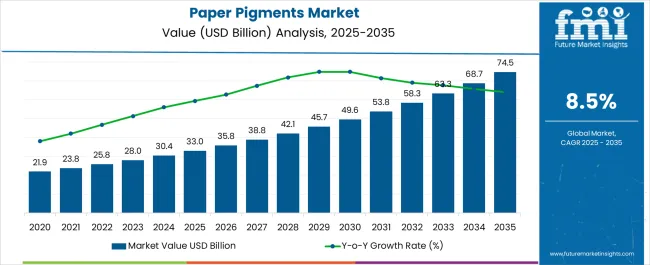
| Metric | Value |
|---|---|
| Paper Pigments Market Estimated Value in (2025 E) | USD 33.0 billion |
| Paper Pigments Market Forecast Value in (2035 F) | USD 74.5 billion |
| Forecast CAGR (2025 to 2035) | 8.5% |
The paper pigments market is experiencing steady growth as demand for high quality paper products continues to rise across publishing, packaging, and specialty printing applications. Growing emphasis on print quality, surface smoothness, and brightness enhancement has supported the adoption of advanced pigments.
Environmental regulations and the shift toward recyclable and sustainable packaging solutions have further accelerated investments in pigment technologies that enable improved performance while reducing ecological impact. Technological progress in coating formulations and dispersion processes is enhancing product efficiency and application versatility.
The outlook remains positive as industries increasingly prioritize premium printing outcomes, packaging differentiation, and compliance with sustainability requirements, thereby ensuring long term opportunities for paper pigment adoption.
The market is segmented by product type, origin, and application and region. By product type, the market is divided into calcium carbonate, ground calcium carbonate (GCC), precipitated calcium carbonate (PCC), kaolin, hydrous kaolin, calcined kaolin, talc, titanium dioxide, and gypsum. In terms of origin, the market is classified into synthetic and natural. Based on application, the market is segmented into coated papers and uncoated papers. Regionally, the market is classified into North America, Latin America, Western Europe, Eastern Europe, Balkan & Baltic Countries, Russia & Belarus, Central Asia, East Asia, South Asia & Pacific, and the Middle East & Africa.
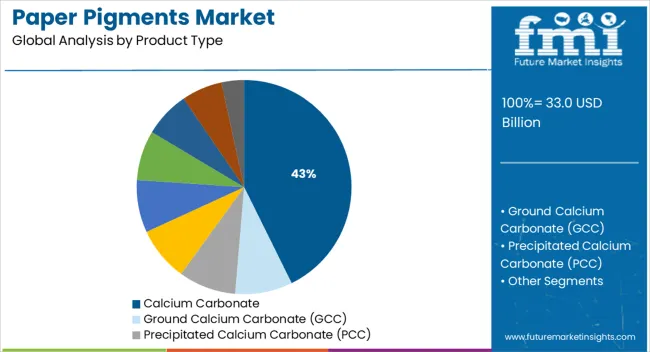
The calcium carbonate segment is projected to hold 42.70% of the overall market by 2025 within the product type category, making it the leading segment. Its dominance is driven by cost effectiveness, abundant availability, and superior opacity and brightness properties that improve paper quality.
The material’s ability to enhance print performance and reduce production costs has led to widespread adoption. It is compatibility with both coated and uncoated papers reinforces its role as the most preferred pigment in the industry.

The synthetic origin segment is expected to account for 56.30% of total revenue by 2025, positioning it as the leading origin type. Its prominence is attributed to the consistency, purity, and controlled particle size distribution it provides, ensuring uniform paper properties.
Synthetic pigments also deliver higher brightness and improved smoothness compared to natural alternatives, supporting their demand in high end printing and packaging applications.
Continuous innovation in production processes is further reinforcing their competitive edge in the market.
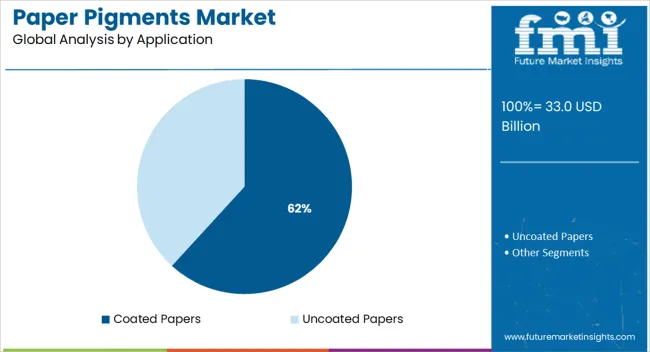
The coated papers application segment is anticipated to capture 61.80% of total revenue by 2025, making it the dominant application area. Growth in this segment is being fueled by rising demand for premium quality printing and packaging materials that require superior surface finish and visual appeal.
Coated papers deliver enhanced print clarity, gloss, and durability, which are highly valued in publishing, advertising, and branded packaging.
As consumer goods industries increasingly adopt visually appealing packaging solutions, coated papers continue to drive the largest share of paper pigment consumption.
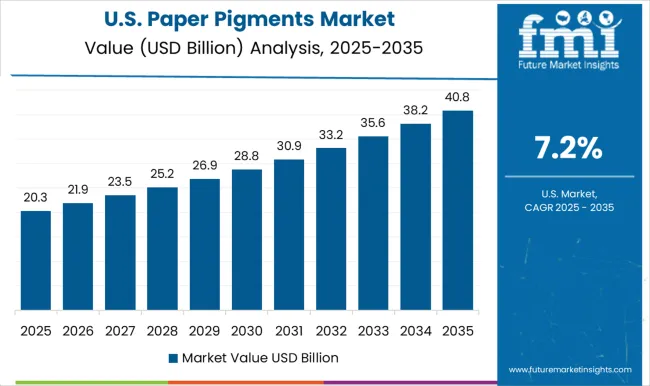
The North American paper pigments market is a growing market due to the increasing demand for paper and paper-based products. The market is driven by factors such as the growing use of paper in packaging, printing, and writing applications, as well as the increasing demand for environmentally-friendly products. The market is also driven by the increasing use of pigments in digital printing, which is expected to increase in popularity in the coming years.
North America is a large consumer of paper-based products, and the market is expected to grow as the region's economy continues to improve. The growth of e-commerce and online retailing is also expected to drive the growth of the paper pigments market share in North America. Some of the major players in the North American paper pigments market include Clariant, Huntsman Corporation, and BASF.
The future of the paper pigments market is expected to be positive, with an increasing demand for paper-based products and a growing preference for environmentally-friendly products. The market is expected to grow at a moderate pace, driven by the increasing use of paper in packaging, printing, and writing applications. Additionally, the growing popularity of digital printing is also expected to drive the demand for paper pigments.
The trend towards sustainable and eco-friendly products is also expected to boost the demand for paper pigments as they are considered more environmentally friendly than dyes.
The increasing demand for lightweight and high-quality packaging materials is also expected to drive the growth of the paper pigments market. Furthermore, the growth of e-commerce and online retailing is also expected to drive the growth of the paper pigments market, as the demand for packaging and printing materials for these applications is expected to increase.
The paper pigments market is expected to grow in the coming years, driven by the increasing demand for paper-based products, the growing preference for environmentally-friendly products, and the increasing use of digital printing technology.
During the production of pulp & paper, various chemicals/pigments are utilized as additives and as processing agents. The selection of these pigments is dependent on the function properties required to be imparted to papers and paperboards, for their designated applications. Paper pigments are powder form particles, insoluble in dissolvent & binders, and obtained from the natural as well as synthetic sources.
Paper pigments has various superior properties including low solubility in water, and help to boost brightness, opacity values of paper, and among others. The key application of paper pigments is to improve printing properties.
Rising concerns towards educational development as well as growing government initiatives related to educational activities are anticipated to fuel the printing & writing papers demand. Along with this, many packaging experts and consumer product companies are focusing on “green packaging”.
Modern retail penetration will boost the demand for paper bags. Due to sustainable packaging, the demand for paper products estimated to surge and manufacturers are increasingly demanding paper pigments in near future.
Paper pigments play a key role in ensuring safe operations through all steps of the paper mill from the gate of the plant, through transportation, to storage and final use of the product in bleaching plants. Paper pigments are helpful to improve the paper look, surface and functional properties.
In view of growing the requirements such as opacity, brightness and print quality, etc. the demand for paper pigments is projected to grow at a decent pace during the forecast period.
Conversely, disruption brought up by digitalization have already benefited several industries. However, it is not the case with pulp and paper industry. Though with moderate intensity, digitalization has negatively impacted the growth of paper demand. With an upsurge in digital media platforms, the newsprint has lagged its growth in the digital era compared to previous year.
This is expected to hamper the global paper pigments market by end of forecast period.
Geographically, the USA has been one of the oldest and most important consumers of paper napkins and other tissue paper products in daily routine. Although overall growth of this regional market will be sluggish, it will continue its dominance over other regions throughout the forecast period.
Despite substantial use of tissue paper products and high number of paper mills, paper & pulp processing chemicals are being purchased within North America, which stands as the predominant driver for paper pigments market growth.
China is likely to remain the key market as it is one of the largest paper and pulp producers; thus, the consumption of paper pigments is estimated to surge across the South Asia paper pigments market. With an increasing population opting to buy packaged products and online shopping, the demand for corrugated packaging materials will be on a rise over the forecast period.
The Indian market for pulp will especially capitalize on growing sales of packaging and writing papers as the government has been allocating higher budget to the education domain. As a result, the global paper pigments market is estimated to fuel the global paper pigments market by end of forecast period.
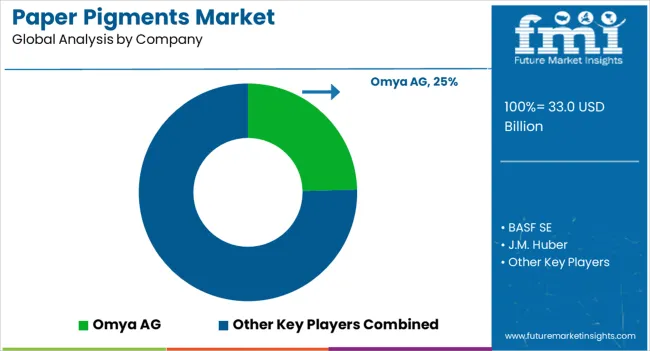
The global paper pigments market is expected to be fairly fragmented owing to the presence of number of manufactures at regional and global level. Few of them identified across the value chain which is as mentioned below:
The paper pigments market report presents a comprehensive assessment of the market and contains thoughtful insights, facts, historical data, and statistically supported and industry-validated market data. It also contains projections using a suitable set of assumptions and methodologies. The research report provides analysis and information according to market segments such as geographies, application, and industry.
The global paper pigments market is estimated to be valued at USD 33.0 billion in 2025.
The market size for the paper pigments market is projected to reach USD 74.5 billion by 2035.
The paper pigments market is expected to grow at a 8.5% CAGR between 2025 and 2035.
The key product types in paper pigments market are calcium carbonate, ground calcium carbonate (gcc), precipitated calcium carbonate (pcc), kaolin, hydrous kaolin, calcined kaolin, talc, titanium dioxide and gypsum.
In terms of origin, synthetic segment to command 56.3% share in the paper pigments market in 2025.






Our Research Products

The "Full Research Suite" delivers actionable market intel, deep dives on markets or technologies, so clients act faster, cut risk, and unlock growth.

The Leaderboard benchmarks and ranks top vendors, classifying them as Established Leaders, Leading Challengers, or Disruptors & Challengers.

Locates where complements amplify value and substitutes erode it, forecasting net impact by horizon

We deliver granular, decision-grade intel: market sizing, 5-year forecasts, pricing, adoption, usage, revenue, and operational KPIs—plus competitor tracking, regulation, and value chains—across 60 countries broadly.

Spot the shifts before they hit your P&L. We track inflection points, adoption curves, pricing moves, and ecosystem plays to show where demand is heading, why it is changing, and what to do next across high-growth markets and disruptive tech

Real-time reads of user behavior. We track shifting priorities, perceptions of today’s and next-gen services, and provider experience, then pace how fast tech moves from trial to adoption, blending buyer, consumer, and channel inputs with social signals (#WhySwitch, #UX).

Partner with our analyst team to build a custom report designed around your business priorities. From analysing market trends to assessing competitors or crafting bespoke datasets, we tailor insights to your needs.
Supplier Intelligence
Discovery & Profiling
Capacity & Footprint
Performance & Risk
Compliance & Governance
Commercial Readiness
Who Supplies Whom
Scorecards & Shortlists
Playbooks & Docs
Category Intelligence
Definition & Scope
Demand & Use Cases
Cost Drivers
Market Structure
Supply Chain Map
Trade & Policy
Operating Norms
Deliverables
Buyer Intelligence
Account Basics
Spend & Scope
Procurement Model
Vendor Requirements
Terms & Policies
Entry Strategy
Pain Points & Triggers
Outputs
Pricing Analysis
Benchmarks
Trends
Should-Cost
Indexation
Landed Cost
Commercial Terms
Deliverables
Brand Analysis
Positioning & Value Prop
Share & Presence
Customer Evidence
Go-to-Market
Digital & Reputation
Compliance & Trust
KPIs & Gaps
Outputs
Full Research Suite comprises of:
Market outlook & trends analysis
Interviews & case studies
Strategic recommendations
Vendor profiles & capabilities analysis
5-year forecasts
8 regions and 60+ country-level data splits
Market segment data splits
12 months of continuous data updates
DELIVERED AS:
PDF EXCEL ONLINE
Market Share Breakdown of Paper Pigments Manufacturers
Paperboard Partition Market Size and Share Forecast Outlook 2025 to 2035
Paper Box Market Size and Share Forecast Outlook 2025 to 2035
Paper Edge Protector Market Size and Share Forecast Outlook 2025 to 2035
Paper Cup Lids Market Size and Share Forecast Outlook 2025 to 2035
Paper Pallet Market Size and Share Forecast Outlook 2025 to 2035
Paper and Paperboard Packaging Market Forecast and Outlook 2025 to 2035
Paper Wrap Market Size and Share Forecast Outlook 2025 to 2035
Paper Cups Market Size and Share Forecast Outlook 2025 to 2035
Paper Core Market Size and Share Forecast Outlook 2025 to 2035
Paper Bags Market Size and Share Forecast Outlook 2025 to 2035
Paper Processing Resins Market Size and Share Forecast Outlook 2025 to 2035
Paper Tester Market Size and Share Forecast Outlook 2025 to 2035
Paper Napkin Converting Lines Market Size and Share Forecast Outlook 2025 to 2035
Paper Packaging Tapes Market Size and Share Forecast Outlook 2025 to 2035
Paper Napkins Converting Machines Market Size and Share Forecast Outlook 2025 to 2035
Paper Coating Binders Market Size and Share Forecast Outlook 2025 to 2035
Paper Core Cutting Machine Market Size and Share Forecast Outlook 2025 to 2035
Paper Recycling Market Size and Share Forecast Outlook 2025 to 2035
Paper Release Liners Market Size and Share Forecast Outlook 2025 to 2035

Thank you!
You will receive an email from our Business Development Manager. Please be sure to check your SPAM/JUNK folder too.
Chat With
MaRIA